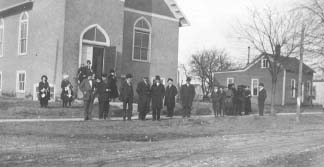| | and preaching services, as well as Manual Training and Sewing rooms for the children was dedicated. Sunday School was held every Sunday afternoon, followed by a short sermon by some minister of the town . On Saturday, sewing and manual training classes were conducted for the children of the district. This work was done through the Volunteer Band, and offered splendid opportunity for practical mission work. The people in the district of the Chapel responded in a beautiful way to the service rendered them. The Chapel was the property of the College, but the work there was in the hands of the Mission Band. Annual Report on the Museum to the Annual Members Meeting January 13, 2003 Thanks to the Museum committee: Mary Chrastil, Art Gilbert, David Grandstaff, Steven Hammer, Bonnie Ingraham, Ralph Naragon, Phil Orpurt, Tim Taylor, Robin Lahman, Bill Firstenberger, consultant and Jeanne Anderson, Project director. The building assessment was done by Pyramid Architecture/Engineering and Construction Administration, Inc. In general the building is in satisfactory condition but, as expected the heating and cooling and electrical systems need to be upgraded. To achieve ADA compliance an elevator is needed. Exterior repairs like tuck pointing and some roof repair is needed. Some structural support the main floor and the second floor are desirable for full usage. A First Annual Fund drive was conducted led by Debbie Chinworth and Sharon Fruitt for funds for current operation. Thanks to their good planning and hard work, the goal was met. Volunteer work for the museum work has been excellent and old shelving has been removed, several dumpsters of trash collected combined with hours of cleaning and painting changed the appearance of the building The official name chosen is North Manchester Center for History, Phone number 260-982-0672 e-mail nmhistory@kconline,net. A Logo has been designed . The artifacts were unpacked after the move a year ago. Work has progressed on identifying photographs. Most of the artifacts have been accessioned and stored and records are computerized. There has | |
